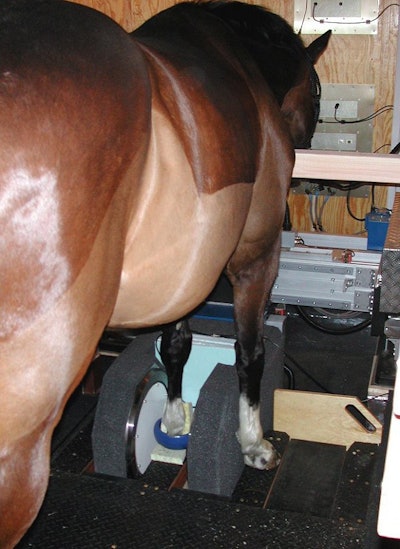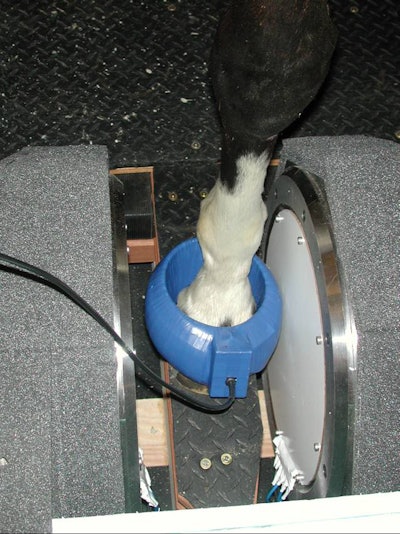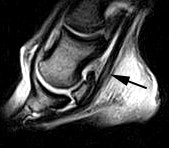
For equine athletes, life just keeps getting better. The grueling long-distance endurance phase of the equestrian competition has been eliminated from the 2004 Olympic Games in Athens. And if horses are injured, they can now be imaged with an MRI scanner designed just for them.
The new 0.21-tesla scanner from Hallmarq Veterinary Imaging of Guilford, U.K., represents a significant advance for horses and horse medicine, said veterinarian Dr. Nathaniel White, director of the Marion duPont Scott Equine Medical Center in Leesburg, VA.
"We see problems we’ve not been able to diagnose before," White said, "problems in the tendons, ligaments, and bones that were not showing up in any other modality."
As recently as the 2000 Olympic Games in Sydney, the only way to get an MR image of a horse was to fully anesthetize and arrange the animal for a scanner designed for humans. The new machine enables imaging of a standing, lightly sedated horse using a large, U-shaped magnet that can be moved up and down the leg from (unshod) hoof to hock.
 |
| A patient undergoes imaging in the equine limb MRI scanner. All images courtesy of the Marion duPont Scott Equine Medical Center. |
 |
The benefits of MR imaging for horses are akin to those for humans. In horses, the machine is particularly helpful in finding bone bruises and hoof injuries, allowing doctors to make a sharper diagnosis than the catch-all "navicular disease."
"We have long suspected that navicular syndrome was actually a number of different pathologies," said veterinarian Dr. Paul McClellan, whose Equest Diagnostic Imaging Center in San Marcos, CA, was first in the U.S. to obtain the standing-horse MRI system.
"Now we can see problems in the impar (lower leg to hoof) ligament or deep flexor tendon, and separate different causes of the disease," McClellan said. "Using this technology with radiology and nuclear scintigraphy, we can prognosticate cases with greater accuracy."
Accurate diagnosis is important because, while the show horse is susceptible to accidents and traumatic injuries such as fractures, the vast majority of injuries are from wear and tear in the soft tissues. Horses in athletic contests are prone to joint sprains and arthritis, as well as so-called "bow tendon," a severe tendon or ligament strain that renders a horse lame.
 |
| Sagittal image of horse's foot shows lesion on tendon (arrow). |
Olympic equestrian events are numerous and exhausting, putting horses and their riders through every imaginable pace over three days of competition. There are three competitive categories: dressage, show jumping, and eventing, all of which have deep historical roots. Medals are awarded for both individual and team performances.
Dressage is a French term meaning "training." As an equestrian event, dressage is believed to date back to ancient Greece, though it didn’t gain widespread popularity until it spread across Europe during the Renaissance. According to the United States Equestrian Foundation, the object of dressage is to highlight the horse’s "natural athletic ability and willingness to perform."
To the uninitiated, horses in the dressage appear to be just prancing around a ring. Actually, they are executing prescribed moves and judged in much the same manner as figure skaters on maneuvers including the walk, canter, canter half-pass (a sideways movement), piaffe or trotting in place, and pirouette. In addition to the compulsory exercises, horses perform choreographed routines in a freestyle event.
In show jumping, believed to date back to the 1860s in Paris, horses must beat a clock and navigate 15 to 20 jumps on a course they’ve never seen. Riders are allowed to walk the course beforehand. All the scoring in jumping events is negative, with points deducted for failing to clear jumps cleanly.
The eventing competition is also known as the horse triathlon, combining elements of dressage, endurance running, and jumping. Until this year, the final obstacle course was preceded by an arduous relay phase of 10 miles or more of track trotting, interspersed with 2 miles of steeplechase, and followed by a 5-mile cross-country gallop with obstacles 4 feet high and 10 feet wide.
But all that has been eliminated in a new modified format. Now the only phase in eventing is the final gallop, and even that is just 5,700 meters, compared to an old course that could stretch as long as 7,410 meters. The new course emphasizes riding strategy over strength and endurance. With the same number of obstacles in a shorter course, there’s less time for the horse to rest between leaps, and less time for the rider to prepare.
By Matt King
AuntMinnie.com contributing writer
August 22, 2004
Related Reading
iCRco introduces CR for vets, June 1, 2004
Veterinary imaging and radiotherapy center opens, November 11, 2002
Role of RTs in veterinary medicine is slight, with potential for growth, November 7, 2002
GE, Sound Technologies partner for vet market, February 15, 2002
Radiology's raided turf: three views from the field, March 20, 2001
Copyright © 2004 AuntMinnie.com


.fFmgij6Hin.png?auto=compress%2Cformat&fit=crop&h=100&q=70&w=100)





.fFmgij6Hin.png?auto=compress%2Cformat&fit=crop&h=167&q=70&w=250)











